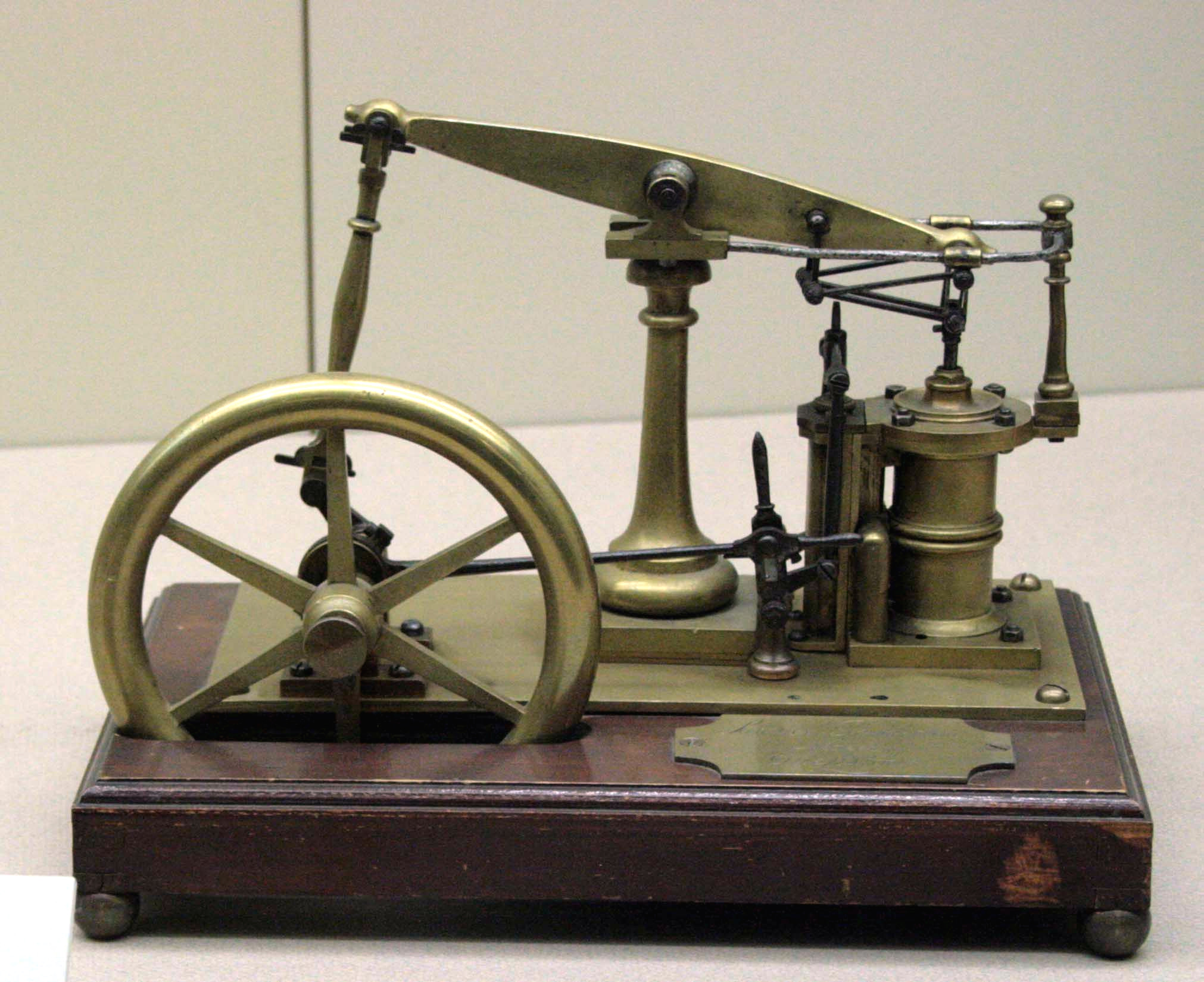

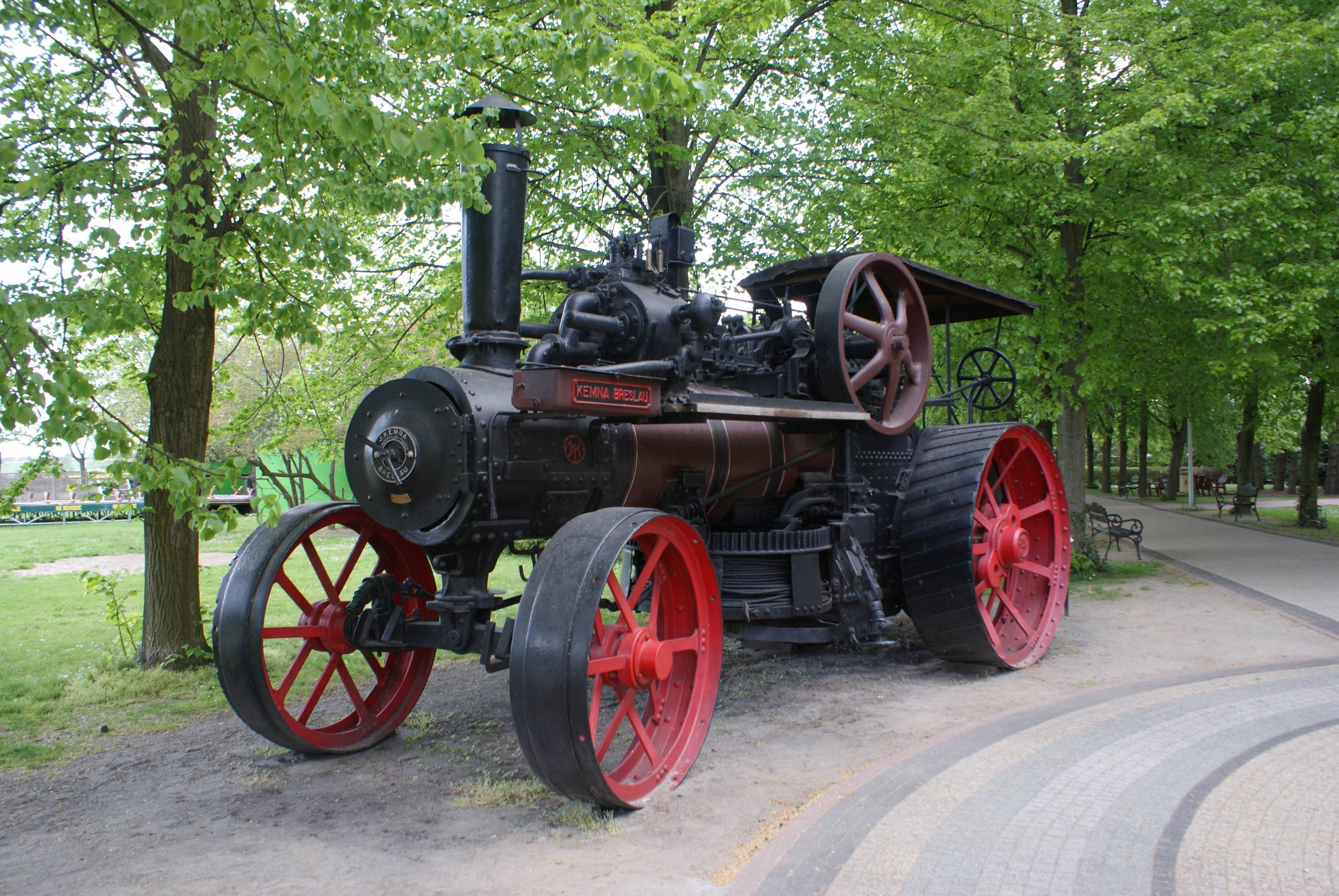 A steam engine is a heat engine that performs mechanical work using steam as its working fluid. The steam engine uses the force produced by steam pressure to push a piston back and forth inside a cylinder. This pushing force can be transformed, by a connecting rod and
A steam engine is a heat engine that performs mechanical work using steam as its working fluid. The steam engine uses the force produced by steam pressure to push a piston back and forth inside a cylinder. This pushing force can be transformed, by a connecting rod and History
Early experiments
One recorded rudimentary steam-powered "engine" was the aeolipile described by Hero of Alexandria, a Greek mathematician and engineer in Roman Egypt in the first century AD. In the following centuries, the few steam-powered "engines" known were, like the aeolipile,''"De Architectura"'': Chapter VI (paragraph 2)from "Ten Books on Architecture" by Vitruvius (1st century BC), published 17, June, 0
accessed 2009-07-07 essentially experimental devices used by inventors to demonstrate the properties of steam. A rudimentary steam turbine device was described by Taqi al-Din Muhammad ibn Ma'ruf, Taqi al-Din Ahmad Y Hassan (1976). ''Taqi al-Din and Arabic Mechanical Engineering'', pp. 34–35. Institute for the History of Arabic Science, University of Aleppo. in Ottoman Egypt in 1551 and by Giovanni Branca in Italy in 1629. The Spanish inventor Jerónimo de Ayanz y Beaumont received patents in 1606 for 50 steam-powered inventions, including a water pump for draining inundated mines. Denis Papin, a Huguenot, did some useful work on the steam digester in 1679, and first used a piston to raise weights in 1690.
Pumping engines
The first commercial steam-powered device was a water pump, developed in 1698 by Thomas Savery. It used condensing steam to create a vacuum which raised water from below and then used steam pressure to raise it higher. Small engines were effective though larger models were problematic. They had a very limited lift height and were prone to boiler explosions. Savery's engine was used in mines,Piston steam engines
 The first commercially successful engine that could transmit continuous power to a machine was the
The first commercially successful engine that could transmit continuous power to a machine was the High-pressure engines
The meaning of high pressure, together with an actual value above ambient, depends on the era in which the term was used. For early use of the term Van Reimsdijk refers to steam being at a sufficiently high pressure that it could be exhausted to atmosphere without reliance on a vacuum to enable it to perform useful work. states that Watt's condensing engines were known, at the time, as low pressure compared to high pressure, non-condensing engines of the same period. Watt's patent prevented others from making high pressure and compound engines. Shortly after Watt's patent expired in 1800, Richard Trevithick and, separately, Oliver Evans in 1801 introduced engines using high-pressure steam; Trevithick obtained his high-pressure engine patent in 1802, and Evans had made several working models before then. These were much more powerful for a given cylinder size than previous engines and could be made small enough for transport applications. Thereafter, technological developments and improvements in manufacturing techniques (partly brought about by the adoption of the steam engine as a power source) resulted in the design of more efficient engines that could be smaller, faster, or more powerful, depending on the intended application. The Cornish engine was developed by Trevithick and others in the 1810s. It was a compound cycle engine that used high-pressure steam expansively, then condensed the low-pressure steam, making it relatively efficient. The Cornish engine had irregular motion and torque through the cycle, limiting it mainly to pumping. Cornish engines were used in mines and for water supply until the late 19th century.Horizontal stationary engine
Early builders of stationary steam engines considered that horizontal cylinders would be subject to excessive wear. Their engines were therefore arranged with the piston axis in vertical position. In time the horizontal arrangement became more popular, allowing compact, but powerful engines to be fitted in smaller spaces. The acme of the horizontal engine was the Corliss steam engine, patented in 1849, which was a four-valve counter flow engine with separate steam admission and exhaust valves and automatic variable steam cutoff. When Corliss was given the Rumford Medal, the committee said that "no one invention since Watt's time has so enhanced the efficiency of the steam engine". In addition to using 30% less steam, it provided more uniform speed due to variable steam cut off, making it well suited to manufacturing, especially cotton spinning.Road vehicles
 The first experimental road-going steam-powered vehicles were built in the late 18th century, but it was not until after Richard Trevithick had developed the use of high-pressure steam, around 1800, that mobile steam engines became a practical proposition. The first half of the 19th century saw great progress in steam vehicle design, and by the 1850s it was becoming viable to produce them on a commercial basis. This progress was dampened by legislation which limited or prohibited the use of steam-powered vehicles on roads. Improvements in vehicle technology continued from the 1860s to the 1920s. Steam road vehicles were used for many applications. In the 20th century, the rapid development of
The first experimental road-going steam-powered vehicles were built in the late 18th century, but it was not until after Richard Trevithick had developed the use of high-pressure steam, around 1800, that mobile steam engines became a practical proposition. The first half of the 19th century saw great progress in steam vehicle design, and by the 1850s it was becoming viable to produce them on a commercial basis. This progress was dampened by legislation which limited or prohibited the use of steam-powered vehicles on roads. Improvements in vehicle technology continued from the 1860s to the 1920s. Steam road vehicles were used for many applications. In the 20th century, the rapid development of Marine engines
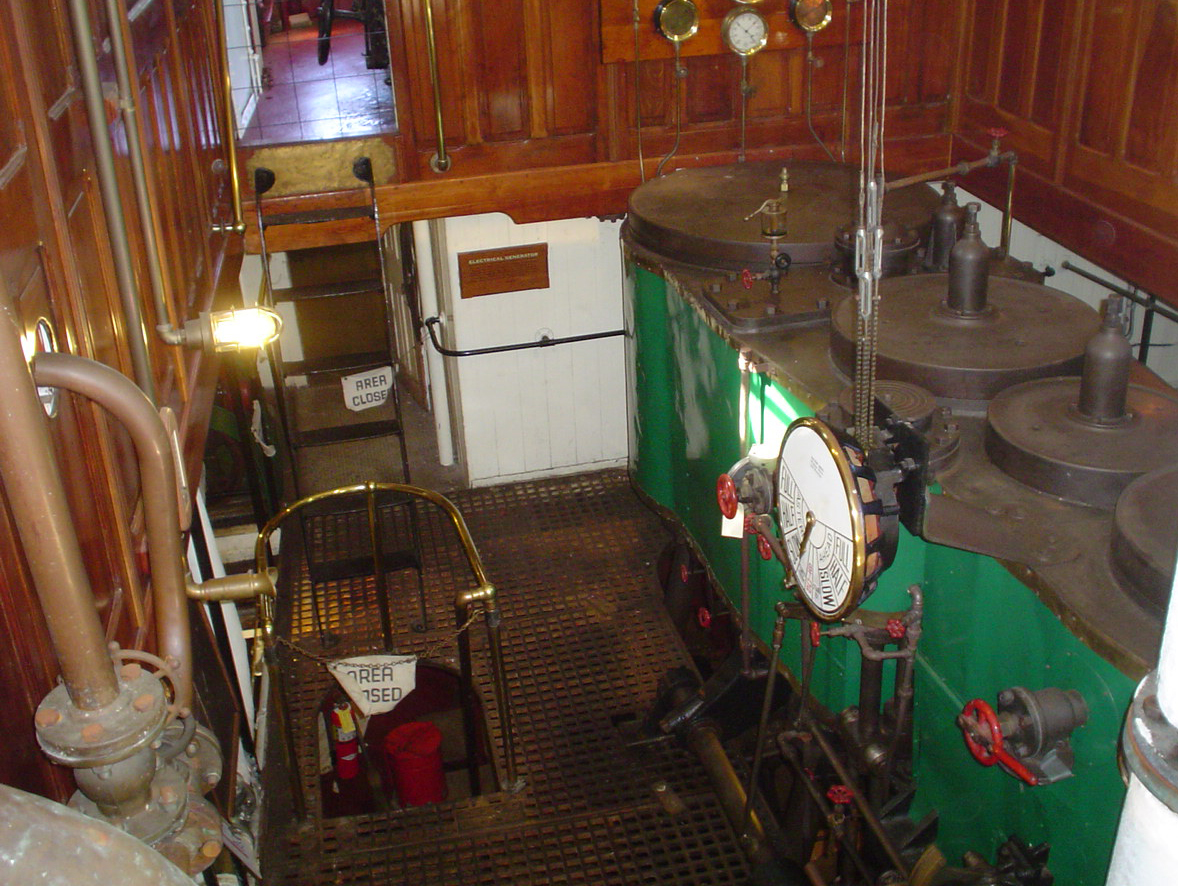 Near the end of the 19th century, compound engines came into widespread use. Compound engines exhausted steam into successively larger cylinders to accommodate the higher volumes at reduced pressures, giving improved efficiency. These stages were called expansions, with double- and triple-expansion engines being common, especially in shipping where efficiency was important to reduce the weight of coal carried. Steam engines remained the dominant source of power until the early 20th century, when advances in the design of the steam turbine,
Near the end of the 19th century, compound engines came into widespread use. Compound engines exhausted steam into successively larger cylinders to accommodate the higher volumes at reduced pressures, giving improved efficiency. These stages were called expansions, with double- and triple-expansion engines being common, especially in shipping where efficiency was important to reduce the weight of coal carried. Steam engines remained the dominant source of power until the early 20th century, when advances in the design of the steam turbine, Steam locomotives
As the development of steam engines progressed through the 18th century, various attempts were made to apply them to road and railway use. In 1784, William Murdoch, a The first full-scale working railway steam locomotive was built by Richard Trevithick in the
The first full-scale working railway steam locomotive was built by Richard Trevithick in the Steam turbines
The final major evolution of the steam engine design was the use of steam turbines starting in the late part of the 19th century. Steam turbines are generally more efficient than reciprocating piston type steam engines (for outputs above several hundred horsepower), have fewer moving parts, and provide rotary power directly instead of through a connecting rod system or similar means. Steam turbines virtually replaced reciprocating engines in electricity generating stations early in the 20th century, where their efficiency, higher speed appropriate to generator service, and smooth rotation were advantages. Today most electric power is provided by steam turbines. In the United States, 90% of the electric power is produced in this way using a variety of heat sources. Steam turbines were extensively applied for propulsion of large ships throughout most of the 20th century.Present development
Although the reciprocating steam engine is no longer in widespread commercial use, various companies are exploring or exploiting the potential of the engine as an alternative to internal combustion engines.Components and accessories of steam engines
There are two fundamental components of a steam plant: the boiler or steam generator, and the "motor unit", referred to itself as a "steam engine". Stationary steam engines in fixed buildings may have the boiler and engine in separate buildings some distance apart. For portable or mobile use, such as steam locomotives, the two are mounted together. The widely used reciprocating engine typically consisted of a cast-iron cylinder, piston, connecting rod and beam or a crank and flywheel, and miscellaneous linkages. Steam was alternately supplied and exhausted by one or more valves. Speed control was either automatic, using a governor, or by a manual valve. The cylinder casting contained steam supply and exhaust ports. Engines equipped with a condenser are a separate type than those that exhaust to the atmosphere. Other components are often present; pumps (such as an injector) to supply water to the boiler during operation, condensers to recirculate the water and recover the latent heat of vaporisation, and superheaters to raise the temperature of the steam above its saturated vapour point, and various mechanisms to increase the draft for fireboxes. When coal is used, a chain or screw stoking mechanism and its drive engine or motor may be included to move the fuel from a supply bin (bunker) to the firebox.Heat source
The heat required for boiling the water and raising the temperature of the steam can be derived from various sources, most commonly from burning combustible materials with an appropriate supply of air in a closed space (e.g., combustion chamber, firebox, furnace). In the case of model or toy steam engines and a few full scale cases, the heat source can be an electric heating element.Boilers
 Boilers are pressure vessels that contain water to be boiled, and features that transfer the heat to the water as effectively as possible.
The two most common types are:
; Water-tube boiler: Water is passed through tubes surrounded by hot gas.
; Fire-tube boiler: Hot gas is passed through tubes immersed in water, the same water also circulates in a water jacket surrounding the firebox and, in high-output locomotive boilers, also passes through tubes in the firebox itself (thermic syphons and security circulators).
Fire-tube boilers were the main type used for early high-pressure steam (typical steam locomotive practice), but they were to a large extent displaced by more economical water tube boilers in the late 19th century for marine propulsion and large stationary applications.
Many boilers raise the temperature of the steam after it has left that part of the boiler where it is in contact with the water. Known as superheating it turns ' wet steam' into ' superheated steam'. It avoids the steam condensing in the engine cylinders, and gives a significantly higher efficiency.
Boilers are pressure vessels that contain water to be boiled, and features that transfer the heat to the water as effectively as possible.
The two most common types are:
; Water-tube boiler: Water is passed through tubes surrounded by hot gas.
; Fire-tube boiler: Hot gas is passed through tubes immersed in water, the same water also circulates in a water jacket surrounding the firebox and, in high-output locomotive boilers, also passes through tubes in the firebox itself (thermic syphons and security circulators).
Fire-tube boilers were the main type used for early high-pressure steam (typical steam locomotive practice), but they were to a large extent displaced by more economical water tube boilers in the late 19th century for marine propulsion and large stationary applications.
Many boilers raise the temperature of the steam after it has left that part of the boiler where it is in contact with the water. Known as superheating it turns ' wet steam' into ' superheated steam'. It avoids the steam condensing in the engine cylinders, and gives a significantly higher efficiency.
Motor units
In a steam engine, a piston or steam turbine or any other similar device for doing mechanical work takes a supply of steam at high pressure and temperature and gives out a supply of steam at lower pressure and temperature, using as much of the difference in steam energy as possible to do mechanical work. These "motor units" are often called 'steam engines' in their own right. Engines using compressed air or other gases differ from steam engines only in details that depend on the nature of the gas although compressed air has been used in steam engines without change.Cold sink
As with all heat engines, the majority of primary energy must be emitted as waste heat at relatively low temperature. The simplest cold sink is to vent the steam to the environment. This is often used on steam locomotives to avoid the weight and bulk of condensers. Some of the released steam is vented up the chimney so as to increase the draw on the fire, which greatly increases engine power, but reduces efficiency. Sometimes the waste heat from the engine is useful itself, and in those cases, very high overall efficiency can be obtained. Steam engines in stationary power plants use surface condensers as a cold sink. The condensers are cooled by water flow from oceans, rivers, lakes, and often by cooling towers which evaporate water to provide cooling energy removal. The resulting condensed hot water (''condensate''), is then pumped back up to pressure and sent back to the boiler. A dry-type cooling tower is similar to an automobile radiator and is used in locations where water is costly. Waste heat can also be ejected by evaporative (wet) cooling towers, which use a secondary external water circuit that evaporates some of flow to the air. River boats initially used aWater pump
Most steam boilers have a means to supply water whilst at pressure, so that they may be run continuously. Utility and industrial boilers commonly use multi-stage centrifugal pumps; however, other types are used. Another means of supplying lower-pressure boiler feed water is an injector, which uses a steam jet usually supplied from the boiler. Injectors became popular in the 1850s but are no longer widely used, except in applications such as steam locomotives. It is the pressurization of the water that circulates through the steam boiler that allows the water to be raised to temperatures well above boiling point of water at one atmospheric pressure, and by that means to increase the efficiency of the steam cycle.Monitoring and control
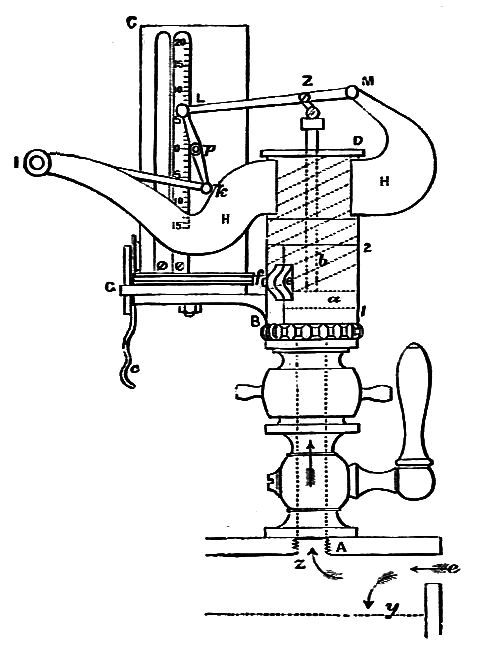 For safety reasons, nearly all steam engines are equipped with mechanisms to monitor the boiler, such as a pressure gauge and a sight glass to monitor the water level.
Many engines, stationary and mobile, are also fitted with a governor to regulate the speed of the engine without the need for human interference.
The most useful instrument for analyzing the performance of steam engines is the steam engine indicator. Early versions were in use by 1851, but the most successful indicator was developed for the high speed engine inventor and manufacturer Charles Porter by Charles Richard and exhibited at London Exhibition in 1862. The steam engine indicator traces on paper the pressure in the cylinder throughout the cycle, which can be used to spot various problems and calculate developed horsepower. It was routinely used by engineers, mechanics and insurance inspectors. The engine indicator can also be used on internal combustion engines. See image of indicator diagram below (in ''Types of motor units'' section).
For safety reasons, nearly all steam engines are equipped with mechanisms to monitor the boiler, such as a pressure gauge and a sight glass to monitor the water level.
Many engines, stationary and mobile, are also fitted with a governor to regulate the speed of the engine without the need for human interference.
The most useful instrument for analyzing the performance of steam engines is the steam engine indicator. Early versions were in use by 1851, but the most successful indicator was developed for the high speed engine inventor and manufacturer Charles Porter by Charles Richard and exhibited at London Exhibition in 1862. The steam engine indicator traces on paper the pressure in the cylinder throughout the cycle, which can be used to spot various problems and calculate developed horsepower. It was routinely used by engineers, mechanics and insurance inspectors. The engine indicator can also be used on internal combustion engines. See image of indicator diagram below (in ''Types of motor units'' section).
Governor
 The centrifugal governor was adopted by James Watt for use on a steam engine in 1788 after Watt's partner Boulton saw one on the equipment of a flour mill Boulton & Watt were building. The governor could not actually hold a set speed, because it would assume a new constant speed in response to load changes. The governor was able to handle smaller variations such as those caused by fluctuating heat load to the boiler. Also, there was a tendency for oscillation whenever there was a speed change. As a consequence, engines equipped only with this governor were not suitable for operations requiring constant speed, such as cotton spinning. The governor was improved over time and coupled with variable steam cut off, good speed control in response to changes in load was attainable near the end of the 19th century.
The centrifugal governor was adopted by James Watt for use on a steam engine in 1788 after Watt's partner Boulton saw one on the equipment of a flour mill Boulton & Watt were building. The governor could not actually hold a set speed, because it would assume a new constant speed in response to load changes. The governor was able to handle smaller variations such as those caused by fluctuating heat load to the boiler. Also, there was a tendency for oscillation whenever there was a speed change. As a consequence, engines equipped only with this governor were not suitable for operations requiring constant speed, such as cotton spinning. The governor was improved over time and coupled with variable steam cut off, good speed control in response to changes in load was attainable near the end of the 19th century.
Engine configuration
Simple engine
In a simple engine, or "single expansion engine" the charge of steam passes through the entire expansion process in an individual cylinder, although a simple engine may have one or more individual cylinders. It is then exhausted directly into the atmosphere or into a condenser. As steam expands in passing through a high-pressure engine, its temperature drops because no heat is being added to the system; this is known as adiabatic expansion and results in steam entering the cylinder at high temperature and leaving at lower temperature. This causes a cycle of heating and cooling of the cylinder with every stroke, which is a source of inefficiency. The dominant efficiency loss in reciprocating steam engines is cylinder condensation and re-evaporation. The steam cylinder and adjacent metal parts/ports operate at a temperature about halfway between the steam admission saturation temperature and the saturation temperature corresponding to the exhaust pressure. As high-pressure steam is admitted into the working cylinder, much of the high-temperature steam is condensed as water droplets onto the metal surfaces, significantly reducing the steam available for expansive work. When the expanding steam reaches low pressure (especially during the exhaust stroke), the previously deposited water droplets that had just been formed within the cylinder/ports now boil away (re-evaporation) and this steam does no further work in the cylinder. There are practical limits on the expansion ratio of a steam engine cylinder, as increasing cylinder surface area tends to exacerbate the cylinder condensation and re-evaporation issues. This negates the theoretical advantages associated with a high ratio of expansion in an individual cylinder.Compound engines
A method to lessen the magnitude of energy loss to a very long cylinder was invented in 1804 by British engineer Arthur Woolf, who patented his ''Woolf high-pressure compound engine'' in 1805. In the compound engine, high-pressure steam from the boiler expands in a high-pressure (HP) cylinder and then enters one or more subsequent lower-pressure (LP) cylinders. The complete expansion of the steam now occurs across multiple cylinders, with the overall temperature drop within each cylinder reduced considerably. By expanding the steam in steps with smaller temperature range (within each cylinder) the condensation and re-evaporation efficiency issue (described above) is reduced. This reduces the magnitude of cylinder heating and cooling, increasing the efficiency of the engine. By staging the expansion in multiple cylinders, variations of torque can be reduced. To derive equal work from lower-pressure cylinder requires a larger cylinder volume as this steam occupies a greater volume. Therefore, the bore, and in rare cases the stroke, are increased in low-pressure cylinders, resulting in larger cylinders. Double-expansion (usually known as compound) engines expanded the steam in two stages. The pairs may be duplicated or the work of the large low-pressure cylinder can be split with one high-pressure cylinder exhausting into one or the other, giving a three-cylinder layout where cylinder and piston diameter are about the same, making the reciprocating masses easier to balance. Two-cylinder compounds can be arranged as: * Cross compounds: The cylinders are side by side. * Tandem compounds: The cylinders are end to end, driving a common connecting rod * Angle compounds: The cylinders are arranged in a V (usually at a 90° angle) and drive a common crank. With two-cylinder compounds used in railway work, the pistons are connected to the cranks as with a two-cylinder simple at 90° out of phase with each other (''quartered''). When the double-expansion group is duplicated, producing a four-cylinder compound, the individual pistons within the group are usually balanced at 180°, the groups being set at 90° to each other. In one case (the first type of Vauclain compound), the pistons worked in the same phase driving a common crosshead and crank, again set at 90° as for a two-cylinder engine. With the three-cylinder compound arrangement, the LP cranks were either set at 90° with the HP one at 135° to the other two, or in some cases, all three cranks were set at 120°. The adoption of compounding was common for industrial units, for road engines and almost universal for marine engines after 1880; it was not universally popular in railway locomotives where it was often perceived as complicated. This is partly due to the harsh railway operating environment and limited space afforded by the loading gauge (particularly in Britain, where compounding was never common and not employed after 1930). However, although never in the majority, it was popular in many other countries.Multiple-expansion engines
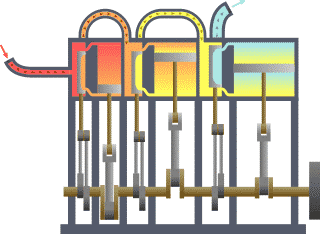 It is a logical extension of the compound engine (described above) to split the expansion into yet more stages to increase efficiency. The result is the multiple-expansion engine. Such engines use either three or four expansion stages and are known as ''triple-'' and ''quadruple-expansion engines'' respectively. These engines use a series of cylinders of progressively increasing diameter. These cylinders are designed to divide the work into equal shares for each expansion stage. As with the double-expansion engine, if space is at a premium, then two smaller cylinders may be used for the low-pressure stage. Multiple-expansion engines typically had the cylinders arranged inline, but various other formations were used. In the late 19th century, the Yarrow-Schlick-Tweedy balancing "system" was used on some marine triple-expansion engines. Y-S-T engines divided the low-pressure expansion stages between two cylinders, one at each end of the engine. This allowed the crankshaft to be better balanced, resulting in a smoother, faster-responding engine which ran with less vibration. This made the four-cylinder triple-expansion engine popular with large passenger liners (such as the ''Olympic'' class), but this was ultimately replaced by the virtually vibration-free turbine engine. It is noted, however, that triple-expansion reciprocating steam engines were used to drive the World War II
It is a logical extension of the compound engine (described above) to split the expansion into yet more stages to increase efficiency. The result is the multiple-expansion engine. Such engines use either three or four expansion stages and are known as ''triple-'' and ''quadruple-expansion engines'' respectively. These engines use a series of cylinders of progressively increasing diameter. These cylinders are designed to divide the work into equal shares for each expansion stage. As with the double-expansion engine, if space is at a premium, then two smaller cylinders may be used for the low-pressure stage. Multiple-expansion engines typically had the cylinders arranged inline, but various other formations were used. In the late 19th century, the Yarrow-Schlick-Tweedy balancing "system" was used on some marine triple-expansion engines. Y-S-T engines divided the low-pressure expansion stages between two cylinders, one at each end of the engine. This allowed the crankshaft to be better balanced, resulting in a smoother, faster-responding engine which ran with less vibration. This made the four-cylinder triple-expansion engine popular with large passenger liners (such as the ''Olympic'' class), but this was ultimately replaced by the virtually vibration-free turbine engine. It is noted, however, that triple-expansion reciprocating steam engines were used to drive the World War II Types of motor units
Reciprocating piston
 In most reciprocating piston engines, the steam reverses its direction of flow at each stroke (counterflow), entering and exhausting from the same end of the cylinder. The complete engine cycle occupies one rotation of the crank and two piston strokes; the cycle also comprises four ''events'' – admission, expansion, exhaust, compression. These events are controlled by valves often working inside a ''steam chest'' adjacent to the cylinder; the valves distribute the steam by opening and closing steam ''ports'' communicating with the cylinder end(s) and are driven by valve gear, of which there are many types.
The simplest valve gears give events of fixed length during the engine cycle and often make the engine rotate in only one direction. Many however have a reversing mechanism which additionally can provide means for saving steam as speed and momentum are gained by gradually "shortening the cutoff" or rather, shortening the admission event; this in turn proportionately lengthens the expansion period. However, as one and the same valve usually controls both steam flows, a short cutoff at admission adversely affects the exhaust and compression periods which should ideally always be kept fairly constant; if the exhaust event is too brief, the totality of the exhaust steam cannot evacuate the cylinder, choking it and giving excessive compression (''"kick back"'').
In the 1840s and 1850s, there were attempts to overcome this problem by means of various patent valve gears with a separate, variable cutoff expansion valve riding on the back of the main slide valve; the latter usually had fixed or limited cutoff. The combined setup gave a fair approximation of the ideal events, at the expense of increased friction and wear, and the mechanism tended to be complicated. The usual compromise solution has been to provide ''lap'' by lengthening rubbing surfaces of the valve in such a way as to overlap the port on the admission side, with the effect that the exhaust side remains open for a longer period after cut-off on the admission side has occurred. This expedient has since been generally considered satisfactory for most purposes and makes possible the use of the simpler
In most reciprocating piston engines, the steam reverses its direction of flow at each stroke (counterflow), entering and exhausting from the same end of the cylinder. The complete engine cycle occupies one rotation of the crank and two piston strokes; the cycle also comprises four ''events'' – admission, expansion, exhaust, compression. These events are controlled by valves often working inside a ''steam chest'' adjacent to the cylinder; the valves distribute the steam by opening and closing steam ''ports'' communicating with the cylinder end(s) and are driven by valve gear, of which there are many types.
The simplest valve gears give events of fixed length during the engine cycle and often make the engine rotate in only one direction. Many however have a reversing mechanism which additionally can provide means for saving steam as speed and momentum are gained by gradually "shortening the cutoff" or rather, shortening the admission event; this in turn proportionately lengthens the expansion period. However, as one and the same valve usually controls both steam flows, a short cutoff at admission adversely affects the exhaust and compression periods which should ideally always be kept fairly constant; if the exhaust event is too brief, the totality of the exhaust steam cannot evacuate the cylinder, choking it and giving excessive compression (''"kick back"'').
In the 1840s and 1850s, there were attempts to overcome this problem by means of various patent valve gears with a separate, variable cutoff expansion valve riding on the back of the main slide valve; the latter usually had fixed or limited cutoff. The combined setup gave a fair approximation of the ideal events, at the expense of increased friction and wear, and the mechanism tended to be complicated. The usual compromise solution has been to provide ''lap'' by lengthening rubbing surfaces of the valve in such a way as to overlap the port on the admission side, with the effect that the exhaust side remains open for a longer period after cut-off on the admission side has occurred. This expedient has since been generally considered satisfactory for most purposes and makes possible the use of the simpler Compression
Before the exhaust phase is quite complete, the exhaust side of the valve closes, shutting a portion of the exhaust steam inside the cylinder. This determines the compression phase where a cushion of steam is formed against which the piston does work whilst its velocity is rapidly decreasing; it moreover obviates the pressure and temperature shock, which would otherwise be caused by the sudden admission of the high-pressure steam at the beginning of the following cycle.Lead in the valve timing
The above effects are further enhanced by providing ''lead'': as was later discovered with theUniflow (or unaflow) engine
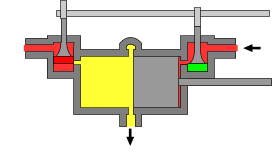 Uniflow engines attempt to remedy the difficulties arising from the usual counterflow cycle where, during each stroke, the port and the cylinder walls will be cooled by the passing exhaust steam, whilst the hotter incoming admission steam will waste some of its energy in restoring the working temperature. The aim of the uniflow is to remedy this defect and improve efficiency by providing an additional port uncovered by the piston at the end of each stroke making the steam flow only in one direction. By this means, the simple-expansion uniflow engine gives efficiency equivalent to that of classic compound systems with the added advantage of superior part-load performance, and comparable efficiency to turbines for smaller engines below one thousand horsepower. However, the thermal expansion gradient uniflow engines produce along the cylinder wall gives practical difficulties..
Uniflow engines attempt to remedy the difficulties arising from the usual counterflow cycle where, during each stroke, the port and the cylinder walls will be cooled by the passing exhaust steam, whilst the hotter incoming admission steam will waste some of its energy in restoring the working temperature. The aim of the uniflow is to remedy this defect and improve efficiency by providing an additional port uncovered by the piston at the end of each stroke making the steam flow only in one direction. By this means, the simple-expansion uniflow engine gives efficiency equivalent to that of classic compound systems with the added advantage of superior part-load performance, and comparable efficiency to turbines for smaller engines below one thousand horsepower. However, the thermal expansion gradient uniflow engines produce along the cylinder wall gives practical difficulties..
Turbine engines
 A steam turbine consists of one or more ''
A steam turbine consists of one or more '' The main use for steam turbines is in electricity generation (in the 1990s about 90% of the world's electric production was by use of steam turbines) however the recent widespread application of large gas turbine units and typical combined cycle power plants has resulted in reduction of this percentage to the 80% regime for steam turbines. In electricity production, the high speed of turbine rotation matches well with the speed of modern electric generators, which are typically direct connected to their driving turbines. In marine service, (pioneered on the '' Turbinia''), steam turbines with reduction gearing (although the Turbinia has direct turbines to propellers with no reduction gearbox) dominated large ship propulsion throughout the late 20th century, being more efficient (and requiring far less maintenance) than reciprocating steam engines. In recent decades, reciprocating Diesel engines, and gas turbines, have almost entirely supplanted steam propulsion for marine applications.
Virtually all nuclear power plants generate electricity by heating water to provide steam that drives a turbine connected to an
The main use for steam turbines is in electricity generation (in the 1990s about 90% of the world's electric production was by use of steam turbines) however the recent widespread application of large gas turbine units and typical combined cycle power plants has resulted in reduction of this percentage to the 80% regime for steam turbines. In electricity production, the high speed of turbine rotation matches well with the speed of modern electric generators, which are typically direct connected to their driving turbines. In marine service, (pioneered on the '' Turbinia''), steam turbines with reduction gearing (although the Turbinia has direct turbines to propellers with no reduction gearbox) dominated large ship propulsion throughout the late 20th century, being more efficient (and requiring far less maintenance) than reciprocating steam engines. In recent decades, reciprocating Diesel engines, and gas turbines, have almost entirely supplanted steam propulsion for marine applications.
Virtually all nuclear power plants generate electricity by heating water to provide steam that drives a turbine connected to an Oscillating cylinder steam engines
An oscillating cylinder steam engine is a variant of the simple expansion steam engine which does not require valves to direct steam into and out of the cylinder. Instead of valves, the entire cylinder rocks, or oscillates, such that one or more holes in the cylinder line up with holes in a fixed port face or in the pivot mounting ( trunnion). These engines are mainly used in toys and models, because of their simplicity, but have also been used in full-size working engines, mainly on ships where their compactness is valued.Rotary steam engines
It is possible to use a mechanism based on a pistonless rotary engine such as the Wankel engine in place of the cylinders and valve gear of a conventional reciprocating steam engine. Many such engines have been designed, from the time of James Watt to the present day, but relatively few were actually built and even fewer went into quantity production; see link at bottom of article for more details. The major problem is the difficulty of sealing the rotors to make them steam-tight in the face of wear and thermal expansion; the resulting leakage made them very inefficient. Lack of expansive working, or any means of control of the cutoff, is also a serious problem with many such designs. By the 1840s, it was clear that the concept had inherent problems and rotary engines were treated with some derision in the technical press. However, the arrival of electricity on the scene, and the obvious advantages of driving a dynamo directly from a high-speed engine, led to something of a revival in interest in the 1880s and 1890s, and a few designs had some limited success.. Of the few designs that were manufactured in quantity, those of the Hult Brothers Rotary Steam Engine Company of Stockholm, Sweden, and the spherical engine of Beauchamp Tower are notable. Tower's engines were used by the Great Eastern Railway to drive lighting dynamos on their locomotives, and by the Admiralty for driving dynamos on board the ships of the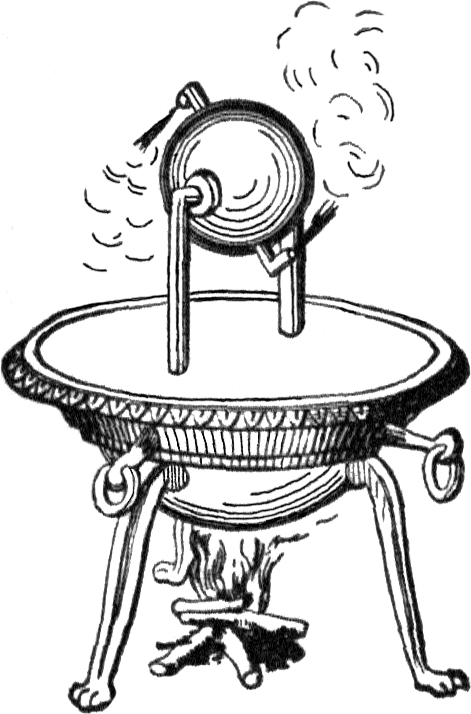
Rocket type
The aeolipile represents the use of steam by the rocket-reaction principle, although not for direct propulsion. In more modern times there has been limited use of steam for rocketry – particularly for rocket cars. Steam rocketry works by filling a pressure vessel with hot water at high pressure and opening a valve leading to a suitable nozzle. The drop in pressure immediately boils some of the water and the steam leaves through a nozzle, creating a propulsive force. Ferdinand Verbiest's carriage was powered by an aeolipile in 1679.Safety
Steam engines possess boilers and other components that are pressure vessels that contain a great deal of potential energy. Steam escapes and boiler explosions (typicallySteam cycle
 The Rankine cycle is the fundamental thermodynamic underpinning of the steam engine. The cycle is an arrangement of components as is typically used for simple power production, and uses the phase change of water (boiling water producing steam, condensing exhaust steam, producing liquid water)) to provide a practical heat/power conversion system. The heat is supplied externally to a closed loop with some of the heat added being converted to work and the waste heat being removed in a condenser. The Rankine cycle is used in virtually all steam power production applications. In the 1990s, Rankine steam cycles generated about 90% of all electric power used throughout the world, including virtually all
The Rankine cycle is the fundamental thermodynamic underpinning of the steam engine. The cycle is an arrangement of components as is typically used for simple power production, and uses the phase change of water (boiling water producing steam, condensing exhaust steam, producing liquid water)) to provide a practical heat/power conversion system. The heat is supplied externally to a closed loop with some of the heat added being converted to work and the waste heat being removed in a condenser. The Rankine cycle is used in virtually all steam power production applications. In the 1990s, Rankine steam cycles generated about 90% of all electric power used throughout the world, including virtually all Efficiency
The efficiency of an engine cycle can be calculated by dividing the energy output of mechanical work that the engine produces by the energy put into the engine by the burning fuel. The historical measure of a steam engine's energy efficiency was its "duty". The concept of duty was first introduced by Watt in order to illustrate how much more efficient his engines were over the earlier Newcomen designs. Duty is the number of foot-pounds of work delivered by burning one bushel (94 pounds) of coal. The best examples of Newcomen designs had a duty of about 7 million, but most were closer to 5 million. Watt's original low-pressure designs were able to deliver duty as high as 25 million, but averaged about 17. This was a three-fold improvement over the average Newcomen design. Early Watt engines equipped with high-pressure steam improved this to 65 million. No heat engine can be more efficient than the Carnot cycle, in which heat is moved from a high-temperature reservoir to one at a low temperature, and the efficiency depends on the temperature difference. For the greatest efficiency, steam engines should be operated at the highest steam temperature possible ( superheated steam), and release the waste heat at the lowest temperature possible. The efficiency of a Rankine cycle is usually limited by the working fluid. Without the pressure reaching supercritical levels for the working fluid, the temperature range over which the cycle can operate is small; in steam turbines, turbine entry temperatures are typically 565 °C (theSee also
Notes
References
References
* * * * * * * * * * *Further reading
* * * * Rose, Joshua. (1887, reprint 2003) ''Modern Steam Engines'' * * * Van Riemsdijk, J.T. (1980) ''Pictorial History of Steam Power''. * (lecture)External links
Animated engines – Illustrates a variety of engines
Video of the 1900 steam engine aboard paddle steamer Unterwalden
{{Authority control 18th-century inventions Energy conversion English inventions Gas technologies Piston engines